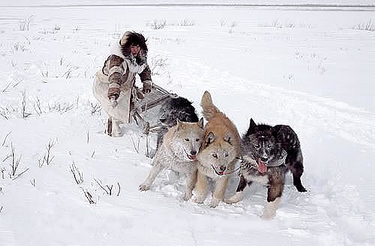For more than 1,000 years a tribe known as the Chukci have inhabited the Arctic coastal region of northern Siberia - a land where the extremes of winter make daily life a constant challenge just for survival. It is there that the Chukci dog, the progenitor of today's Siberian Husky was developed.
Over many generations of breeding, the Chukci developed the type of dog that most suited their needs. Although their permanent home was inland, the Chukci hunters worked primarily along the coast with seal as their main food. The hunters' catch was not so heavy as to require large dogs capable of pulling great weight. Instead, the Chukci hunters needed a dog that could withstand exposure to low temperatures, pull a light to medium load quickly over long distances and expend a minimum amount of energy in the process. The less energy the dog used on its work, the more it had left to protect it from the weather.
Quick, small working dogs that were docile and intelligent enough to work in teams proved to be most suited to the work and the terrain. They had to be hard, eager workers that had enough common sense and dedication to their task to keep from constantly tangling themselves in the lines of the sled. The Chukci so valued their dogs that they often took them into their homes as guardians for their children. This, no doubt, accounts for much of the gentleness of the Siberian Husky personality.
The Chukci's dog most important trait was its instinct and desire to run, seemingly endlessly. Because of its moderate size, it was able to run far and fast, but it could not pull much weight. Therefore teams of up to 20 dogs at a time were required to pull the hunter's load. The Chukci were able to breed a dog that combined all these traits, and today's Siberian Husky traces back to these dogs.
The fate of the Chukci dog - and the birth of the Siberian Husky breed are tied to several historical events, primarily in Russia. In the eighteenth century Russian Cossacks began a march across Siberia to conquer the land and thereby attain all its resources, primarily fur. Most of the people living in the northern area belonged to rather primitive tribal groups unable to compete with the weaponry of the invading Russian army. The Chukci people were able to withstand conquest, however, because their sled dogs always kept them ahead of the advancing army. They could not fight but they could run - efficiently. The Chukci were accustomed to the Siberian weather, the Russian soldiers were not and suffered great losses.
The Chukci actually forced the Cossacks to give up their quest to conquer all of northern Siberia. The Chukci lured the Russian forces into a mountain pass in which all escape routes were blocked. Using only sharpened rocks and spears, the Chukci inflicted substantial casualties on the Russians who subsequently withdrew from the area.
The Chukci people existed peaceably in Siberia for many years after this conflict. By the close of the nineteenth century the Chukci dogs were discovered by Alaskan traders, imported into the north west territory and renamed the Siberian Husky. This importation proved to be very popular for the survival of the breed.
In the early 1900s the monarchy in Russia was overthrown and replaced by a Communist regime vowing to do away with all "bourgeois" and elite aspects of Russian life. By the 1930s, the forces of Communism reached the arctic north. Because Chukci dogs were revered highly and desired by the Chukci people, those in the tribe that bred and maintained the finest dogs had assumed a leadership position and measure of wealth. Such people were viewed as hindrances to the forces of collectivation and most were imprisoned or killed. In a matter of a few years the Chukci dog breed all but disappeared from Siberia.
Siberian Huskies and the Growth of Dog Sledding
|


